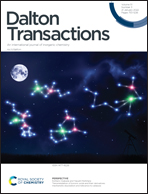2-(4-Hydroxyphenyl)benzothiazole dicarboxylate ester TACN chelators for 64Cu PET imaging in Alzheimer's disease†
Abstract
Herein we report a new series of bifunctional chelators (BFCs) with high affinity for amyloid β aggregates, strong binding affinity towards Cu(II), and favorable lipophilicity for potential blood–brain barrier (BBB) penetration. The alkyl carboxylate ester pendant arms show high binding affinity towards Cu(II). The BFCs form stable 64Cu-radiolabeled complexes and exhibit favorable partition coefficient (log D) values of 0.75–0.95. Among the five compounds tested, 64Cu-YW-1 and 64Cu-YW-13 complexes exhibit significant staining of amyloid plaques in ex vivo autoradiography studies.



 Please wait while we load your content...
Please wait while we load your content...